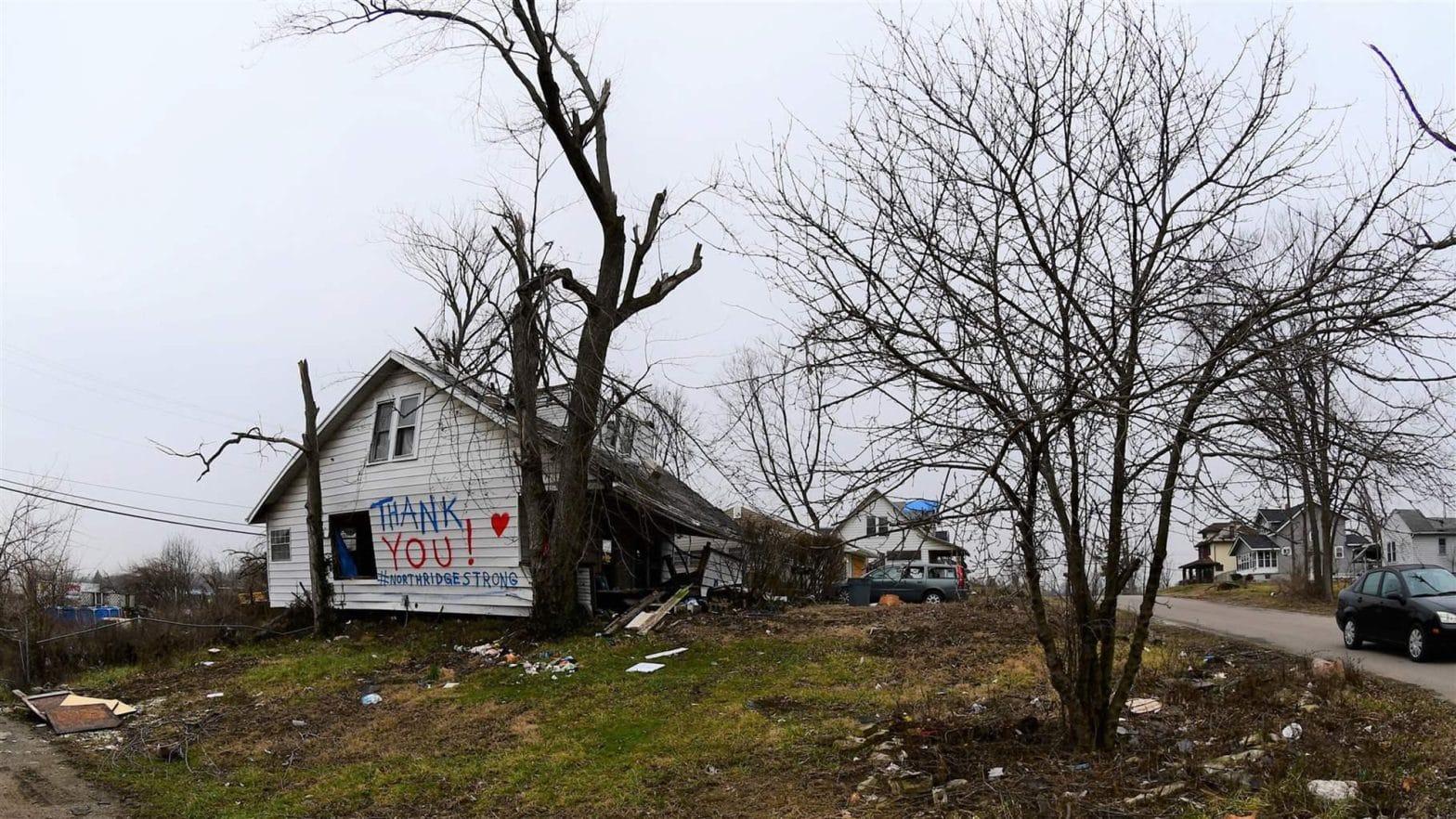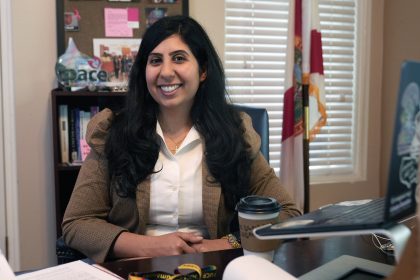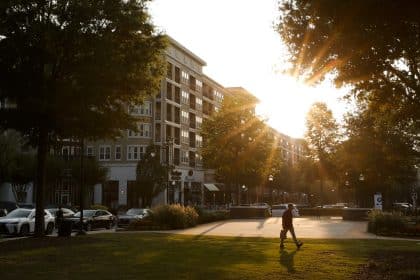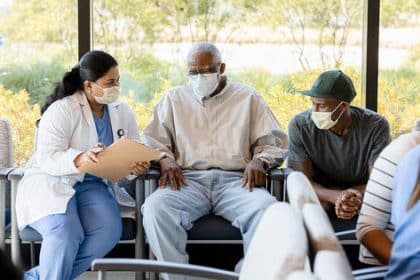Census Gives Opposite Advice to Tornado-Damaged Dayton, Flood-Ravaged Houston

DAYTON, Ohio — Josh Hollon was shocked when he stepped onto his porch on Memorial Day last year and saw three churning triangles of cloud closing in on his house in suburban Northridge, Ohio.
“I had just turned off the news and said, ‘Nothing ever happens here. Forget it,’” Hollon said. “I saw those clouds and I went to my wife and said, ‘Hey, we’ve gotta get into the basement. Now!’”
A series of tornadoes surprised the Dayton area and blew a hole right through the Hollon home, filling the backyard with wreckage. They were lucky to have insurance to make basic repairs.
Many of their neighbors are still fighting to make their homes habitable again, along an 18-mile swath of destruction that left thousands of crumpled houses and apartment buildings across the Dayton area. Hollon can see one or two vacant houses on every block, some torn down completely.
Residents displaced by recent natural disasters in Dayton and elsewhere around the country raise tricky questions for this year’s census count. They’re getting conflicting advice from the U.S. Census Bureau on whether to count themselves at a temporary address or at the damaged homes where they plan to return.
In the Dayton area, partnership specialists working for the Census Bureau’s Philadelphia region advised local officials in an October presentation that people should be counted in their damaged homes even if living elsewhere while waiting for repairs. So local communities are reaching out with that advice and opening facilities for displaced residents to fill out forms.
“People temporarily displaced by natural disasters are to be counted at their usual residence to which they intend to return,” according to the presentation.
In flood-ravaged Houston, the advice was different: People need to be counted wherever they currently live. That advice also came from a partnership specialist working for the Census Bureau, said Larry Nierth, a geographic information officer for the city’s planning department.
“We are taking this to mean that if you are displaced by a hurricane or flood and Census Day comes, you are to be counted where you are living on Census Day (April 1),” Nierth said.
Much depends on the decisions. As natural disasters multiply across the country, due in part to climate change, city and state leaders worry their areas could lose more of the funding they desperately need to continue the cleanup if displaced residents aren’t counted.
Nationwide, $1.5 trillion in federal funds depend on population counts. State funding for schools also relies on head counts.
“This is census meets climate change,” said Terri Ann Lowenthal, a Connecticut-based consultant on census issues.
She noted that there’s a big difference between Dayton, where the scattered damage will be less than a year old on April 1, and Paradise, Calif., where the Camp Fire burned 11,000 houses to the ground in 2018.
“Is a year or more living elsewhere temporary?” Lowenthal asked. “Think about Puerto Rico. Lots of people were displaced in Hurricane Maria (in 2017) and moved to the mainland. Likely they intend to return when their homes are livable, but I don’t think they are being told to count themselves in Puerto Rico.”
In Houston, where flooding has scattered many families, the city and county’s census outreach program includes pleas for host families to include storm refugees on their own official forms.
Both Nierth and Bala Balachandran, Houston’s chief demographer, told Stateline that the Census Bureau advised the city to count people that way, at their temporary residence while waiting for repairs. The conflicting advice in Houston and Ohio appears to stem from different interpretations of census rules by partnership coordinators.
Michael Cook, chief of the Census Bureau’s public information office, said that within the bureau, different regions “have the latitude on finding the best way to get the count” after a storm. People are free to list a storm-damaged home for counting purposes if they’re still getting mail there, or if they use the internet to respond without a mailed census invitation, Cook said.
But problems could arise in those cases, Cook said. The bureau can’t accept a form counting a person at an address if the bureau already had inspected the house after a storm and found it uninhabitable, Cook said. That happened for many homes in Houston in 2019, Nierth said.
And if mail can’t be delivered to a house, that would trigger an in-person visit from a census employee, who also might mark a house uninhabitable — and no one can be counted at that address, Cook said.
“If our field staff determines that the structure isn’t habitable, we can rely on our advertising and promotional efforts to encourage the former residents to respond from wherever they are currently living,” Cook said.
Todd Graham, a Minnesota-based member of the Census Bureau’s national State Data Center Steering Committee, said it’s not yet clear whether the bureau would contact the family to ask for an updated address or would just delete the response listing an address deemed invalid.
“It all sounds precarious,” Graham said. “It is. Small numbers will be missed.”
But he added that new technology still promises a better census count, since for the first time this year, people are free to respond online whether or not the census contacts them with a postcard next month or, if they don’t respond, a knock on the door.
Paradise, where wildfires chased 90% of residents from their homes, already is bracing for a large-scale population drop. It tried to make the best of the situation by asking the state to declare it a rural area, thus entitled to special funding.
Dayton-area communities are trying to find people temporarily living elsewhere and encourage them to count themselves at their damaged homes if they plan to return, said Stacy Schweikhart, a director at the Miami Valley Regional Planning Commission who helps coordinate census outreach efforts.
The suburban city of Trotwood, Ohio, will open a community center with computers, where storm refugees can return to count themselves in the city. And Dayton-area families that sought volunteer assistance with moving after the storms will be advised that they, too, can count themselves at homes where they intend to return.
Anne Kirklin, whose family moved from a damaged Brookville home to Englewood, about 10 miles away, said the storm was traumatic and stressful enough without worrying about the census count, especially when both places are in the same county.
The U.S. Census Bureau briefed local outreach workers like Schweikhart after the storms, noting that every uncounted person could cost Ohio thousands of dollars over the next decade. The presentation included a message for tornado victims: “People temporarily displaced by natural disasters are to be counted at their usual residence to which they intend to return.”
That advice surprised some experts, since Census Bureau policy is to count people where they “live and sleep most of the time,” usually interpreted as where they live on April 1, Census Day.
While residence rules stayed the same this year, the bureau said in its final residence criteria for the 2020 census that the rules allow “temporarily displaced” residents — including disaster victims — to count themselves at their usual home.
That rule “already allows people who are temporarily displaced by natural disasters to be counted at their usual residence to which they intend to return,” the bureau said in its written comment on the rules. The comment was in response to concerns that areas hit by hurricanes or earthquakes could lose funding if people are temporarily absent waiting for home repairs.
Some other experts who have worked with the census in past years also were surprised by the bureau’s advice.
“I hadn’t heard of the policy to count people where they intend to return,” said Steven Romalewski, a director at the City University of New York’s Center for Urban Research.
However, Graham, of the bureau’s state data center committee, agreed that if natural disaster damage to a home is fixable, a family should be able to count itself at their old address — if the disaster victims really do plan to return.
Trotwood, where fixable homes and large apartment complexes sit vacant, plans to open a community center with computers where people can return to be counted at their old addresses, said Stephanie Kellum, Trotwood’s deputy city manager.
Trotwood is in the middle of a revival in the past decade, Democratic Mayor Mary McDonald said, as middle-class African Americans in Dayton find it a desirable suburban retreat with good schools. Some of the damaged apartments were newly renovated, and others had changed from subsidized status to market rate as more prosperous people gravitated to the community, she said.
“We’ve never seen the devastation of a tornado that within a couple of minutes can come through and absolutely destroy your community,” McDonald said. “The census count is so important to us, so we get those funds to serve the people. We’re doing everything we can to find people and let them know.”
For instance, Trotwood has reached out to people who asked for volunteer help to move after the storm, and to parents who asked for bus transportation from nearby areas to keep their children in Trotwood schools while waiting for repairs.
As it was in the working-class suburb of Northridge, the tornadoes came as a shock in Trotwood.
After hearing about an approaching tornado, Trotwood pastor Norman Scearce piled into a bathtub with his wife and three small children as the twister tore the roof off their home. His elderly neighbors were huddled in a stairwell after barely avoiding a tree that crashed into their bedroom.
“It was like something out of a movie. You could hear people just screaming,” Scearce said. “But everybody was OK. That moment when we all came out and we were all unhurt — it was like a miracle.”
The Scearces were able to move back in after several weeks. Many of their neighbors are still gone.
As a member of the local Trotwood-Madison school board, Scearce knew that many families with children fled to nearby areas, continuing to send their children to local schools by requesting temporary bus service.
One child asked for transportation from Columbus, almost 80 miles away — a distance covered partly by a Columbus school bus, which drops the child halfway, where a Trotwood-Madison bus takes over for the second half of the ride.
About 350 children were displaced from a single apartment complex in Scearce’s neighborhood, but he expects almost all of his neighbors to come back eventually.
“Funding is based on population, and if we can’t get people counted, even if they plan to come back, ultimately that hurts funding,” Scearce said. “The fear was that people were just going to take their insurance money and go, but the vast majority has decided to come back and rebuild.”
In the Dayton area, Joel Burton was part of a volunteer effort to help people move donated furniture and other assistance. Census outreach officials advised about 400 people that they could come back and be counted in the area.
“We think there were hundreds of other people who didn’t come to us for help,” Burton said. “They just figured it out on their own, which is good, but we have no idea where those people are now.”
“Are they all coming back? I think a lot of people are,” Burton said. “Some aren’t. I think some people are still deciding what to do.”
———
©2020 Stateline.org
Visit Stateline.org at www.stateline.org
Distributed by Tribune Content Agency, LLC.























